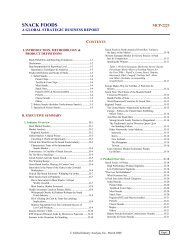the RUSSIA oil & gas competitive intelligence report - Report Buyer
the RUSSIA oil & gas competitive intelligence report - Report Buyer
the RUSSIA oil & gas competitive intelligence report - Report Buyer
Create successful ePaper yourself
Turn your PDF publications into a flip-book with our unique Google optimized e-Paper software.
Russia Oil and Gas Competitive Intelligence <strong>Report</strong> 2010<br />
Market Position<br />
Gazprom accounts for 80% of Russia’s <strong>gas</strong> production (2009) and holds at least two-thirds of <strong>the</strong> nation’s<br />
<strong>gas</strong> reserves (or 15% of world reserves). The company also has a virtual monopoly control over <strong>the</strong><br />
domestic <strong>gas</strong> pipeline network, which supplies fuel to almost every Russian region, <strong>the</strong> CIS states and<br />
over 25 European nations. The firm remains heavily reliant on overseas <strong>gas</strong> sales, as it is forced to supply<br />
<strong>gas</strong> to <strong>the</strong> domestic market at subsidised rates. Domestic prices, however, are gradually being liberalised<br />
and are set to reach around US$70/mcm in 2010 and US$90/mcm in 2011, up from around US$20/mcm<br />
in early 2000s. Notable foreign assets include minority stakes in China’s West-East <strong>gas</strong> pipeline, and in<br />
phases 2 and 3 of Iran’s giant South Pars project.<br />
Strategy<br />
In 2009, Gazprom’s production fell to 460bcm, according to preliminary government figures. This was<br />
<strong>the</strong> worst performance in Gazprom's history, with <strong>the</strong> current low of 512bcm registered in 2001. In Q110,<br />
however, domestic demand began to recover, pushing up Gazprom's production figures. This led CEO<br />
Alexei Miller to announce a more ambitious target of 529bcm for 2010. In April 2010 he told Russian<br />
media that by 2013 <strong>the</strong> company expected to produce 565.5bcm, which would be a 13-year production<br />
high. Speaking at a news conference on June 9, however, Gazprom's <strong>gas</strong> and condensate departmental<br />
head, Vsevolod Cherepanov, said that from mid-May 2010 <strong>the</strong> company had begun to see a much sharper<br />
seasonal drop in demand than it had expected. Cherepanov said that <strong>the</strong> company has now revised its <strong>gas</strong><br />
production forecasts. The company now expects to produce 519.3bcm in 2010, down roughly 10bcm on<br />
Miller's forecasts. He said that <strong>the</strong> company expects this to increase to 528.6bcm in 2011 and to 542.4bcm<br />
in 2012.<br />
By 2030, Gazprom wants to become a global energy player, reaching new markets with LNG and<br />
underwater pipelines. It wants to add 90mn tonnes of LNG capacity by 2030. At present Sakhalin-II is <strong>the</strong><br />
only operational liquefaction terminal. With output at its mature Western Siberia fields in decline,<br />
Gazprom expects new generation projects in <strong>the</strong> Arctic (Yamal, Shtokman), East Siberia (Kovykta,<br />
Chayandinskoye) and <strong>the</strong> Far East (Sakhalin) to fuel future growth, accounting for half of its production<br />
by 2020. Gazprom also planned to supply about 25% of <strong>the</strong> world’s LNG needs by 2030, but that target<br />
was scrapped following <strong>the</strong> decline of <strong>the</strong> US import demand. By early 2010 Gazprom’s executives had<br />
acknowledged <strong>the</strong> need for a strategic overhaul owing to <strong>the</strong> negative impact of rising domestic US <strong>gas</strong><br />
production. In December 2005, <strong>the</strong>n deputy chairman Medvedev announced Gazprom's aim 'to gain more<br />
than 10% of <strong>the</strong> US market by 2010, increasing to 20% [at a later date]'. With US demand for <strong>gas</strong> imports<br />
on <strong>the</strong> wane, <strong>the</strong>se targets are now looking decidedly unrealistic.<br />
Having scuppered Gazprom's North American ambitions, <strong>the</strong> spreading 'shale revolution', is beginning to<br />
pose a threat to its core business closer to home. The first negative consequences are already being felt by<br />
<strong>the</strong> company, as LNG cargoes head for European ports having been turned away from <strong>the</strong> US. There is,<br />
© Business Monitor International Ltd Page 22









